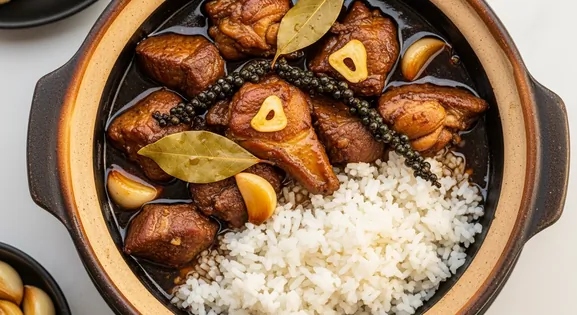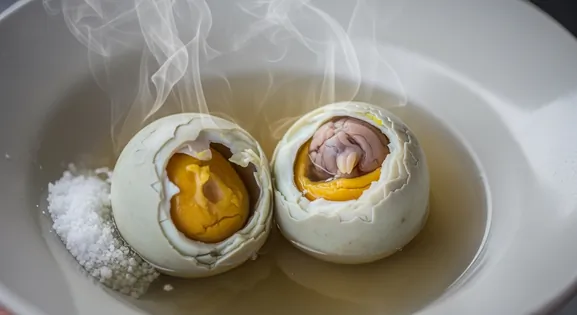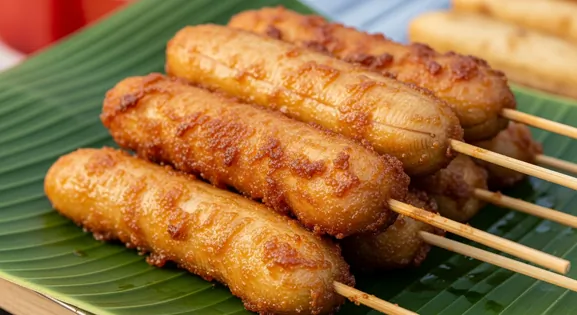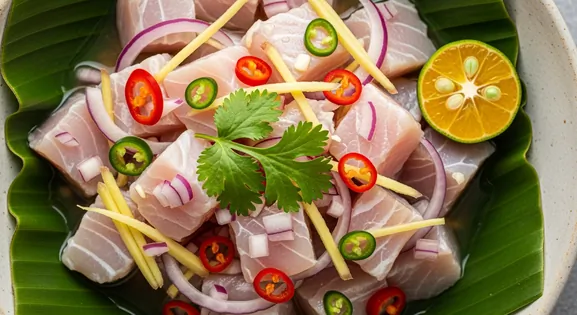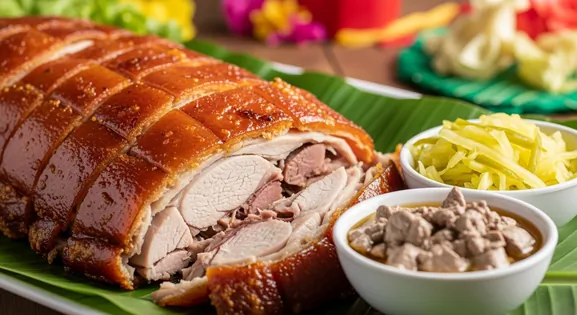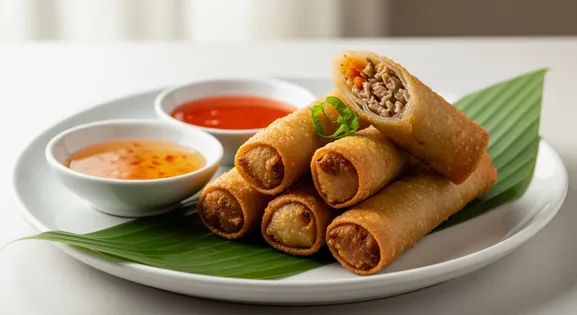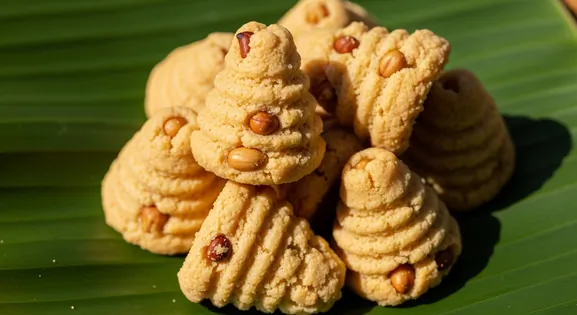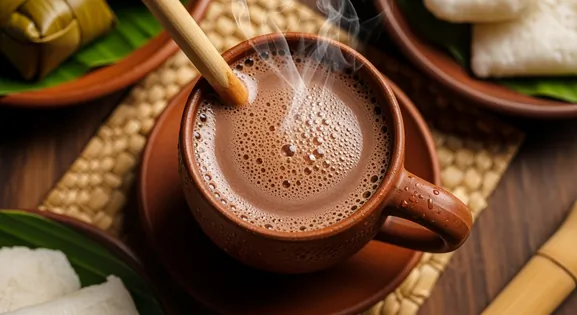Kalamay in Philippines: A Complete Food Lover's Guide
Kalamay

A Culinary Snapshot
Kalamay is a beloved Filipino sweet delicacy made from glutinous rice flour, coconut milk, and brown sugar, cooked until it reaches a sticky, thick consistency. Especially famous in Bohol as 'Kalamay Hati,' it's traditionally sold in coconut shells sealed with bright red paper strips, making it both a delicious treat and iconic souvenir. The name literally means 'mixture of sugar,' highlighting its intensely sweet flavor profile complemented by rich coconut undertones.
Spotting Quality: What to Look For
What to Look For
-
Properly sealed containers with no signs of mold or fermentation
For jarred or packaged Kalamay, ensure lids are tightly sealed without bulging. For traditional coconut shell packaging, check that the red paper strip is securely attached and unbroken.
-
Even, glossy appearance without excessive liquid separation
Quality Kalamay should have a consistent texture throughout. Some oil separation is normal, but excessive amounts indicate poor preparation or old product.
-
Clean, organized vendor setup with proper food handling
Especially important when buying freshly made or unpackaged Kalamay. Vendors should use clean utensils and maintain good hygiene practices.
-
Pleasant sweet aroma with caramel notes
Fresh Kalamay has a distinctively sweet smell. Any sour or fermented odor indicates spoilage.
What to avoid
-
Mold, unusual colors, or bubbling on the surface
These are clear signs of spoilage. Kalamay should have a uniform color without any fuzzy growths or spots.
-
Sour smell or fermented odor
Fresh Kalamay has a sweet aroma. Any sour smell indicates that fermentation has begun and the product should not be consumed.
-
Extremely runny consistency or very dry, cracked surface
Proper Kalamay is sticky and thick but spreadable. Too runny indicates undercooking or poor quality ingredients; too dry suggests it's old or improperly stored.
-
Damaged or improperly sealed packaging
Particularly important for jarred versions or traditional coconut shell packaging. Broken seals allow air and contaminants to enter.
How to Order Kalamay
Perfect Partners: What to Pair
Unsweetened Coffee or Tea
Beverage
The rich, intense sweetness of Kalamay is beautifully balanced by the bitterness of a strong, unsweetened cup of coffee or a robust black tea. This pairing cleanses the palate and allows the distinct flavors of the delicacy to shine.
Fresh Tropical Fruits
Fruit
Serving Kalamay alongside slices of fresh mango, pineapple, or banana provides a refreshing contrast to its dense, sweet texture. The natural acidity and juiciness of the fruit cut through the richness, creating a delightful culinary experience.
Explore Kalamay in Detail: City Guides
Discover where to find the best Kalamay and learn local tips in these cities:
Tracing the Roots of Kalamay
Kalamay has deep roots in Filipino culinary tradition, with variations found across the country. The Bohol version (Kalamay Hati) gained particular prominence during the Spanish colonial period, when it became a specialty offering during religious festivities and later evolved into a sought-after pasalubong (souvenir food gift). The distinctive packaging in coconut shells sealed with red paper strips became tradition in Bohol, symbolizing good luck and prosperity. The labor-intensive preparation process, requiring hours of continuous stirring, has historically made it a communal cooking activity during celebrations.
Crafting the Perfect Dish
Traditional Kalamay preparation is time-consuming and requires significant physical effort. Glutinous rice flour is mixed with coconut milk, brown sugar (or molasses), and sometimes a small amount of lye water (lihiya) as a setting agent. This mixture is cooked over low heat in a large wok or cauldron, requiring constant stirring for several hours until it reaches a thick, sticky consistency where it pulls away from the sides of the pan. The most critical aspect is the continuous stirring to prevent burning and ensure even caramelization. Once cooked, it's topped with latik (coconut curds) made by cooking coconut cream until it forms golden-brown solids. In Bohol, it's then transferred to coconut shell halves while still hot and sealed with distinctive red paper strips.
Key Ingredients of Kalamay
Glutinous Rice Flour (Malagkit)
The foundation of Kalamay, this special rice flour gives the delicacy its signature sticky, chewy texture. It's crucial for achieving the desired consistency.
Quality indicator: Look for a fine, white powder with a slightly sweet, neutral aroma, indicating freshness and purity. Avoid any flour that appears clumpy or discolored.
Coconut Milk (Gata)
Extracted from mature coconuts, coconut milk provides the rich, creamy base and distinct tropical flavor that defines Kalamay. It contributes to the smooth consistency.
Quality indicator: Quality coconut milk should be thick and opaque, with a fresh, sweet coconut aroma. Avoid milk that smells sour or has separated excessively.
Brown Sugar (Muscovado)
This unrefined sugar gives Kalamay its characteristic dark brown color and deep, caramel-like sweetness. It also contributes to the sticky texture.
Quality indicator: Seek out sugar that is moist, dark, and has a rich molasses aroma. Its natural stickiness is a good indicator of quality and freshness.
Local Kalamay Variations in Philippines
Kalamay Hati
The traditional Bohol version, dark brown in color and packaged in coconut shell halves sealed with red paper strips. Topped with latik (coconut curds) and sometimes sesame seeds.
Kalamay Ube
Purple-colored variation made with ube (purple yam), giving it a distinct color and flavor while maintaining the sticky texture.
Kalamay Buna
A variant with whole peanuts mixed into the sticky rice base, adding texture and nutty flavor to the sweet treat.
Kalamay sa Bao
Served in young coconut shells with some of the meat still attached, adding fresh coconut flavor to the experience.
Kalamay Lansong
Packaged in bamboo tubes (lansong) instead of coconut shells, common in some parts of the Philippines outside Bohol.
Dietary Information
Dietary Information
Important Note for Travelers: Your safety is our priority. Below are the common allergens associated with the traditional preparation of this dish. However, recipes and ingredients can vary significantly between establishments. Always confirm all ingredients directly with the food vendor before ordering, especially if you have a severe allergy.
Potential Allergens
Dietary Suitability
Frequently Asked Questions about Kalamay
What is Kalamay?
Kalamay is a traditional Filipino sticky rice cake made from glutinous rice flour, coconut milk, and brown sugar, cooked until it reaches a thick, sticky consistency. It's prized for its sweet taste and distinctively chewy, sticky texture, often topped with latik (coconut curds).
How does Kalamay taste?
Kalamay has a rich, sweet caramel-like flavor from brown sugar or molasses, complemented by creamy coconut notes. The texture is extremely sticky and chewy (the name literally means 'mixture of sugar', highlighting its sweetness). The latik (toasted coconut curds) topping adds a pleasant contrasting crunch with a nutty, roasted flavor.
Is Kalamay a good choice from street vendors?
Kalamay's high sugar content contributes to its stability. When choosing from vendors, prioritize those with clean preparation areas and proper storage. Look for well-sealed products free from mold. Its thorough cooking process also contributes to its quality.
How long does Kalamay last?
Properly sealed Kalamay can last 1-2 weeks at room temperature and up to a month refrigerated due to its high sugar content. Signs of spoilage include mold, fermentation (bubbling), or a sour smell. Once opened, consume within 3-5 days and keep refrigerated.
Is Kalamay vegetarian or vegan?
Traditional Kalamay, made from glutinous rice flour, coconut milk, and brown sugar, is naturally vegan. Latik (fried coconut curds) are also vegan. Some variations might add non-vegan ingredients, but the core dish is plant-based.
Expert How-To Guides about Kalamay
How to Select Quality Kalamay
Learn to identify the characteristics of authentic, high-quality Kalamay, ensuring a delicious and enjoyable experience.
- Look for a glossy, even surface without dry patches or excessive oil separation.
- Check consistency - quality Kalamay should be very sticky but not runny or overly firm.
- Examine the color - traditional Kalamay should be dark brown (from caramelized sugar) without burnt spots.
- Verify the latik topping appears fresh, golden-brown, and crunchy, not soggy or discolored.
- For packaged versions, ensure containers are properly sealed with no signs of mold or fermentation.
- Quality versions will have a pleasant sweet aroma with caramel notes, without any sour smell.
How to Eat Kalamay Like a Local
Discover the best ways to savor Kalamay, embracing traditional Filipino customs for an authentic culinary experience.
- Use a clean spoon rather than your fingers (it's extremely sticky and difficult to wash off).
- Take small portions - Kalamay is very rich and sweet, traditionally enjoyed in modest amounts.
- Pair with unsweetened coffee or tea to balance its intense sweetness.
- For a traditional merienda (snack time), enjoy at room temperature in the afternoon.
- If refrigerated, let it sit for 10-15 minutes before eating for the best texture.
- Some locals enjoy it slightly warmed, which makes it less sticky and enhances the flavor.
Storing Kalamay Properly
Learn effective methods to maximize the shelf life and maintain the quality of your Kalamay, ensuring it stays fresh longer.
- Keep unopened Kalamay in its original sealed container at room temperature away from direct sunlight.
- Once opened, transfer any leftovers to an airtight container and refrigerate.
- If the Kalamay becomes too firm when cold, let it sit at room temperature for 10-15 minutes before serving.
- For longer storage (beyond 2 weeks), refrigeration is recommended, especially in hot, humid weather.
- Avoid introducing water or moisture into the container, which can cause spoilage.
- Check regularly for signs of spoilage such as mold, strange odors, or bubbling.
- If purchasing as pasalubong (souvenir), choose professionally sealed packages for better transportability.
Our Commitment to Quality
At Tasteplorers, our mission is to provide the most accurate and useful travel information in the world. To achieve this, all content on this site is created through our unique editorial framework. We utilize leading AI research tools, guided by our proprietary prompts, and a multi-stage validation process. This entire system is overseen by our editorial team to ensure everything we publish meets our high standards for accuracy, cultural nuance, and practical value for travelers.
Learn more about our Editorial Process and our Mission.
Countries
Explore regions
Europe
Discover Europe's diverse culinary landscape, from Mediterranean flavors to hearty Alpine fare. Learn to navigate markets, decode menus, and eat like a local.
Latin America & Caribbean
Discover the vibrant cuisines of Latin America & the Caribbean. Our expert guide covers everything from Mexican street food to Peruvian ceviche and market tips.
Oceania
Explore Oceania's diverse food scene. Learn about Polynesian earth ovens, Fijian feasts, and the vibrant café culture of Australia and New Zealand.
Southeast Asia
Explore Southeast Asia's diverse food cultures from Thailand to Vietnam. Get expert tips on navigating spice levels, choosing quality vendors, and understanding the rich traditions of the region.
